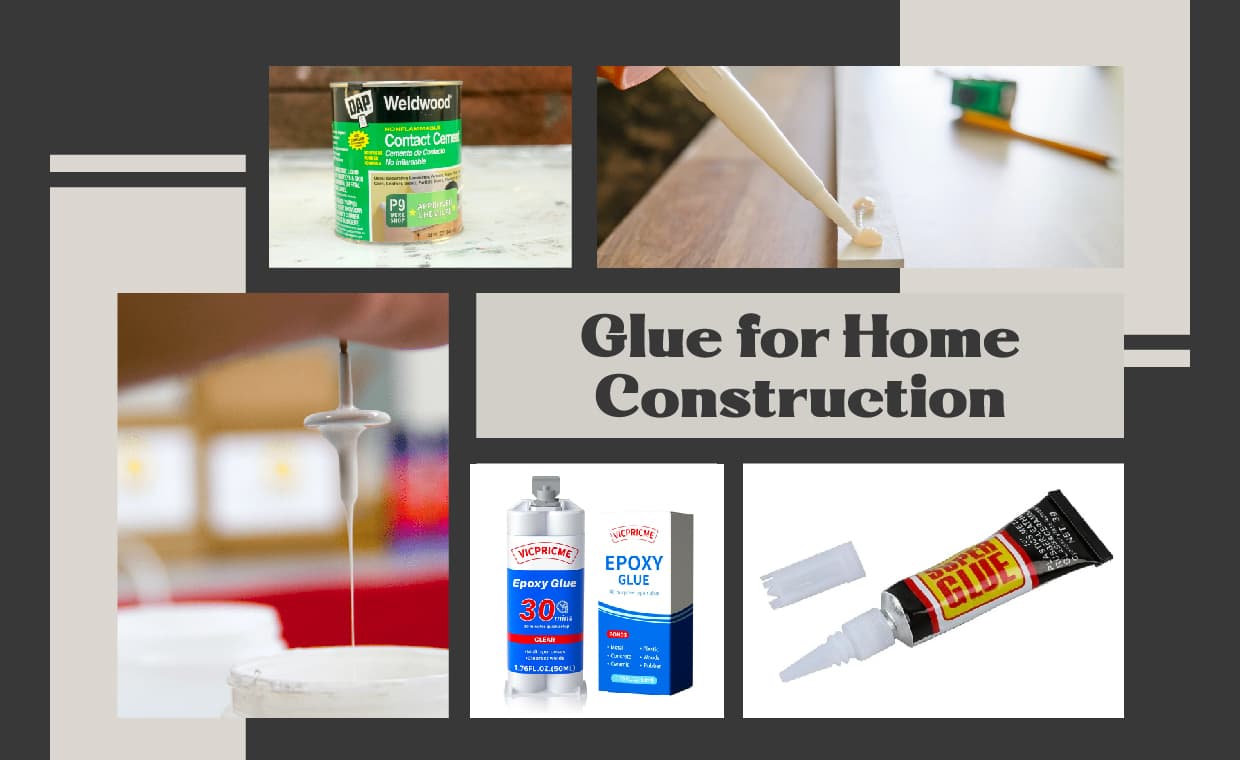
Most of us have been using glue since childhood. Early humans used natural polymers and tree resins to hold items such as basic tools and weapons together. With the advancement of technology, glue is used for construction. Desirable adherence, enhanced performance, and simplified application are necessary for both, time-honoured and cutting-edge building materials, including concrete, plastics, wood panels, etc. In this article, we will discuss different types of glue and precautions to be taken while using glue.
Although “gluing” is far more widespread than “adhering,” glue technically belongs to the larger category of adhesives. While there may have formerly been a clear distinction between glue and adhesives, the latter term has come to encompass both, despite claims by purists that glue exclusively refers to compositions created from natural animal or plant sources.
Types of Glue used in Construction
Some of the important types of glues are:
01. Construction Glue

Construction glue is a strong and weather-resistant glue that helps bond common building materials used in construction and renovation projects. It is available in tubes or cans.
Construction glue comes in two categories: structural and non-structural glue. Decorative materials, such as floor and wall coverings, and other materials that don’t require particularly high strength are bonded with non-structural adhesives. In contrast, structural adhesives are bond structural parts such as masonry, concrete, etc.
02. Wood Glue

Wood glue is essential for carpenters or furniture makers, as this glue bonds many types of wood. Most wood glues are water-soluble and safe for the environment. This glue comes in both quick-drying and slow-drying varieties, allowing you to adjust your project before it sets. It also acts as a wood filler. A strong adhesive, this type of glue is available in interior, waterproof, and water-resistant varieties. This glue sets in one hour to 24 hours. Different types of wood glue are available on the market, such as cyanoacrylate, polyvinyl acetate, etc.
To know more about wood glue, we have written a detailed blog on it. You may refer to the following link:
Overview of Different Types of Wood Adhesives
03. Epoxy Glue

One can apply epoxy glues to various substrates for a security, and water and moisture-resistance. Epoxy glue is popular for its exceptional bond strength and is often used as flooring glue because of its toughness and longevity. Because of its low shrinkage, strong adhesive strength, and resilience to water and chemicals, epoxy has been the adhesive of choice for boat builders for a long time. It sticks well to porous materials like wood, concrete, foam insulation, etc. and non-porous materials like metal and glass when slightly roughed up.
If you want to know about epoxy flooring, you may refer the following link:
Epoxy Flooring: An Ideal Flooring Material Option for your Homes!
04. Super Glue

Super glue, often called cyanoacrylate, is a versatile adhesive that sets-in seconds. Super glue is usually the best choice when you require a fast-setting glue liquid and gel form, you can use this glue on different materials, including porcelain, rubber, plastic, metal, and leather. This quick-bonding adhesive eliminates the need for nails, clamps, and other mechanical fasteners.
05. Spray Glue

Spray glue, a contact adhesive with a solvent base, is a convenient tool for making last-minute fixes. You can spray this solution over localised areas and form strong bond. It is useful for small do-it-yourself repairs, such as furniture and upholstery.
To start, ensure you’re utilising it in a room with plenty of fresh air before you start. It’s important to wait for this glue to dry before applying it to the surface you want to bond. Since spray glue is smelly and dirty, it’s best to use it outdoors, at least 8 inches from the adhesion surface.
06. Contact Cement

Contact cement, an adhesive made of rubber, is useful for bonding surfaces that conventional adhesives can damage. It bonds practically everything, but it works particularly well on nonporous surfaces. It provides a reliable and, long-lasting connection between many substrates, including laminate, glass, rubber, and veneer.
Note: Do not confuse contact cement with rubber cement. Unlike contact cement, rubber cement forms temporarily with non-porous materials. Friction alone is usually enough to get rid of it from hard surfaces. On the other hand, contact cement creates an unbreakable bond that is only compromised by extreme temperatures or chemical solvents.
07. Water-based Glue

Natural polymers and soluble synthetic polymers are often used to create water-based glues. This glue can be purchased pre-made in liquid form or as dry powders that must be reconstituted with water before use. This adhesive can only be used when at least one of the surfaces being adhered to is permeable. A thin coat of adhesive can be applied, allowed to dry, and then activated by wiping with a wet brush or roller or sprayed with water where neither substrate is porous.
08. Hot Glue

Although hot-melt glues have been used for decades in factories, they are a relatively new addition to construction sites. In contrast to its moisture-cured relative, hot-melt glues do not create foam and do not require clamping. It hardens in 30 seconds, has the same water resistance as ordinary polyurethane, but is only about half as strong. These are available in various types, colours, and formulas and can adhere to both porous and non-porous materials. It takes almost no time to dry, making it ideal for bonding small joints or moulding. It is suggested for jobs where high temperatures won’t be an issue. However, glue loses its adhesiveness if heated above its melting point, so keep that in mind if you expose it to high temperatures. Use a glue gun to use it quickly and evenly spread it.
09. Acrylic Glue

Acrylic glue is an emulsion polymerised acrylic ester in water. It is commonly used as an adhesive for ceramic tiles and other decorative floor coverings. In addition to their many other applications, acrylic adhesives can be used to attach other acrylic pieces. Most acrylic adhesives fall into one of two categories: thermoplastics, which may be shaped at temperatures above a particular threshold, or thermosetting polymers, which cannot be reshaped. Strong structural adhesive characteristics have made acrylic adhesives a standard choice. Acrylic glue has a high demand in the market because it is an excellent structural adhesive. In several contexts, it is invaluable as a low-cost structural glue.
Things to Keep in Mind while Using Glue in Construction
Using glue is as simple as stapling something. However, you need to be extra careful and take precautions so that the glue remains strongly adhered and does not come out from the attached surface. Let’s understand in detail:
1. Clean the Surface before Application of Glue

For best results, use the glue as directed and ensure that the bonding surfaces are clean and free of oil or grease before applying the adhesive. If there is any particle between the glue and the attached surface, then the glue will not stick properly, and all your efforts will fail. Some adhesives suggest scuffing the materials attached with coarse sandpaper to enhance the bonding surface area or to provide some mechanical bonding, even though most glues adhere to the substrate at the molecular level.
2. Use Glue as Quickly as You Can

Please observe the written instructions like open/working hours, keeping in mind that higher temperatures will reduce these times. To prevent the adhesives from setting, it is important to spread the glue, attach the surfaces as quickly as possible, and then clamp it. Apply it in a zig-zag pattern so that less glue coats the entire surface. Do not interrupt the work for at least a few hours if you want the best outcomes. Some glue just needs 30 minutes of clamping, but the bond strength won’t be at its best until 24 hours have passed.
03. Check for Expiry Dates

Find the most recent adhesives by checking the expiry date. One must consider the product’s expiry date, as expired glue has less strength and will not serve the required purpose. Many types of glue lose their effectiveness after being opened, so don’t stock up on them and keep them for years. Keep adhesives out of direct light, and store them in a cold, dark place.
04. Take Precautions before Applying Glue

This is the most important step! You must wear latex gloves to avoid glue from falling on your skin and to protect finished surfaces or materials from drips. Glue is difficult to remove without using abrasive cleaners. If wet glue drips onto a finished surface, it should be wiped away with a dry towel, as any moisture will trigger the curing process. The dried glue must be scraped away with a chisel, and the residue must be sanded. Don’t worry if it’s too late, as the dried glue has a tan colour that can be painted over.
Conclusion
There are several other types of glue available in the market. It is up to you to choose one depending on which you want to opt for as it depends on several factors like adhesion surface, the strength of the glue, etc. You can consider reputed brands. Further, you can also approach factories for their recommendation if you are thinking of DIY projects like renovation, repair and so on.
And before you leave, don’t forget to read the following article:
Construction Chemicals: An Essential Component for Speedy Construction!
Image Courtesy: Image 4, Image 5, Image 6, Image 7, Image 8, Image 10
Author Bio
Nafisa Nazneen Choudhury – Nafisa Nazneen Choudhury is a Civil Engineer (completed B.E. from Assam Engineering College) and is currently pursuing M.Tech in Structural Engineering at National Institute of Technology, Silchar. She is a Technical Content Writer, having over 3 years of experience and has wrote many articles related to Civil Engineering. She is also a Book Author (Authored – “Dream Tales of NNC: Revenge By Murder”) and her book can be found on Amazon. She is also a Guest Author at Gharpedia. Moreover, she is a certified member at Institution of Civil Engineers (ICE) and National Society of Professional Engineers (NSPE). She writes her blogs at her website – nnc2017.wordpress.com. She can be reached on LinkedIn.






























